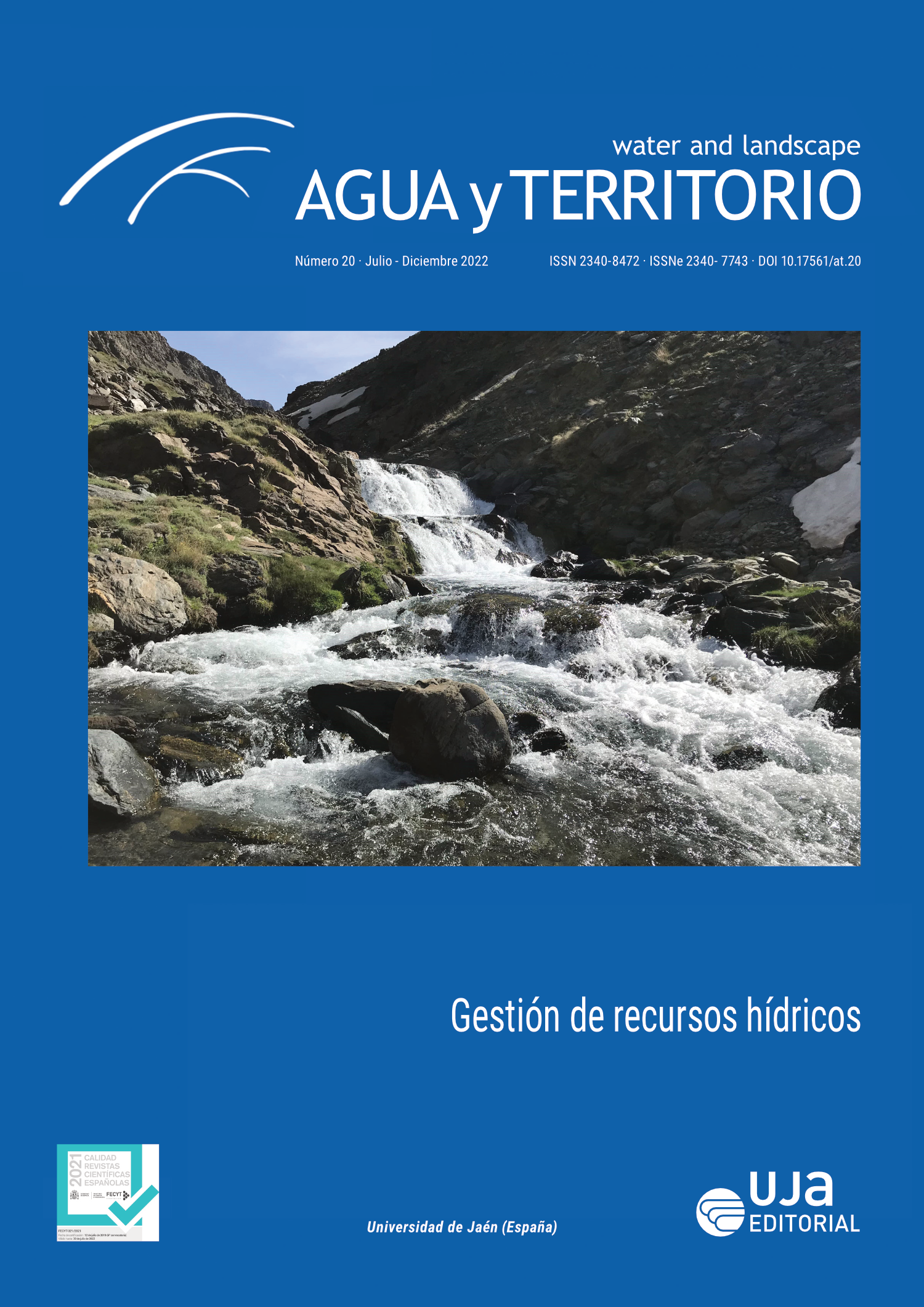Reutilización de aguas residuales, tratadas por fitopurificación, para el riego del Jardín Botánico "le jardin Landon" (Biskra, Algeria). Solución sostenible para la preservación de un sitio de patrimonio material
DOI:
https://doi.org/10.17561/at.20.5270Palabras clave:
Solución sostenible, Fitorremediación, Humedales construidos, Irrigación, Patrimonio materialResumen
Los espacios verdes de la ciudad de Biskra resisten el clima árido de la temporada de verano y, por lo tanto, sufren de escasez de agua, causada principalmente por la evaporación y transpiración de las plantas. Para remediar este problema, el estudio sugiere reutilizar las aguas residuales para el riego después de ser purificadas, utilizando humedales construidos con capacidad mejorada por fitorremediación. Como ejemplo de una solución sostenible, se propone aplicar esta técnica al jardín botánico de la ciudad de Biskra (Algeria), «le jardin Landon». Se propone el diseño de un sistema de humedales construidos. El Landon Garden fue creado en 1870 por el conde Landon de Longueville, decorado con una variedad de flora de los trópicos y los países ecuatoriales. Actualmente se considera patrimonio material nacional.
Descargas
Referencias
Adrados, B., Sánchez, O., Arias, C. A., Becares, E., Garrido, L., Mas, J., Brix, H. & Morató, J. 2014: “Microbial communities from different types of natural wastewater treatment systems: Vertical and horizontal flow constructed wetlands and biofilters”. Water Research, (55), 304-312. https://doi.org/10.1016/j.watres.2014.02.011
Brix, H. 1987: “Treatment of wastewater in the rhizosphere of wetland plants the root-zone method”. Water Science and Technology, 19 (1-2), 107-118. https://doi.org/10.2166/wst.1987.0193
Brix, H. & Arias, C. A. 2005: “The use of vertical flow constructed wetlands for on-site treatment of domestic wastewater: New Danish guidelines”. Ecological Engineering, (25), 491-500. https://doi.org/10.1016/j.ecoleng.2005.07.009
Bulc, T. G. 2006: “Long term performance of a constructed wetland for landfill leachate treatment”. Ecological Engineering, 26 (4), 365-374. https://doi.org/10.1016/j.ecoleng.2006.01.003
Butterwortha, E., Richards, A., Jones, M., Brix, H., Dotroa, G. & Jefferson, B. 2016: “Impact of aeration on macrophyte establishment in sub-surface constructed wetlands used for tertiary treatment of sewage”. Ecological Engineering, (91), 65-73. https://doi.org/10.1016/j.ecoleng.2016.01.017
EPA, 1993: Subsurface flow constructed wetlands for wastewater treatment. United States Environmental Protection Agency, Office of Water (USA).
EPA, 1999: Manual Constructed Wetlands Treatment of Municipal Wastewaters. National Risk Management, Research Laboratory, Office of Research and Development U.S., Ohio 45268 (USA), Environmental Protection Agency Cincinnati.
García, J., Salas, J. J., Martín, I. & Vymazal, J. 2013: “Research and innovation on ecotechnologies applied to improve wastewater treatment efficiency”. Ecological Engineering, (50), 1-4. https://doi.org/10.1016/j.ecoleng.2012.09.003
Gorelova, S. V. & Frontasyeva, M. V. 2017: “The use of higher plants in biomonitoring and environmental bioremediation”, in Ansari, A. A., Gill, S. S., Lanza, G. R. & Newman, L. (Eds.), Phytoremediation: Management of Environmental Contaminants. Volume 5. Cham (Switzerland), Springer, 103-155. https://doi.org/10.1007/978-3-319-52381-1_5
Hammer, D. A. (Ed.). 1989: Constructed Wetlands for Wastewater Treatment: Municipal, Industrial and Agricultural. Florida (USA), Lewis Publishers, CRC Press Company.
Healy, M. G., Rodgers, M. & Mulqueen, J. 2007: “Treatment of dairy wastewater using constructed wetlands and Intermittent sand filters”. Bioresource Technology, (98), 2268-2281. https://doi.org/10.1016/j.biortech.2006.07.036
Lajo, M. e Luther, P. 2007: Biopiscine – Progettazione ed Esecuzione. Techniche e Normativa. Napoli (Italia), Esse libri.
Reed, S. C. & Brown, D. 1995: “Subsurface Flow Wetlands – A performance evolution”. Water Environment Research, 67 (2), 244-248. https://doi.org/10.2175/106143095X131420
Reed, S. C., Middlebrooks, E. J. & Crites, R. W. 1988: Natural Systems for Waste Management and Treatment. New York (USA), McGraw-Hill Book Co.
Seghairi, N., Mimeche, L., Debabeche, M. et Hamzaoui, A. 2014: “Elimination du Cuivre Present Dans les Eaux Usees Industrielles Sur un Filtre Planté de Tamarix”. Courrier du Savoir, (15), 53-57.
Vymazal, J. 2010: “Constructed Wetlands for Wastewater Treatment Sciences”. Water, (2), 530-549. https://doi.org/10.3390/w2030530
Vymazal, J. 2011: “Plants used in constructed wetlands with horizontal subsurface flow: a review”. Hydrobiologia, 674 (1), 133- 156. https://doi.org/0.1007/s10750-011-0738-9
Vystavna, Y., Frkova, Z., Marchand, L., Vergeles, Y. & Stolberg, F. 2017: “Removal efficiency of pharmaceuticals in a full scale constructed wetland in East Ukraine”. Ecological Engineering, (108), 50-58. https://doi.org/10.1016/j.ecoleng.2017.08.009
Descargas
Publicado
Número
Sección
Licencia
Derechos de autor 2021 Mahmoud Debabèche, Ayoub Barkat , Mohamed Ali Boukebous

Esta obra está bajo una licencia internacional Creative Commons Atribución 4.0.
© Universidad de Jaén
Los originales publicados en las ediciones impresa y electrónica de esta Revista son propiedad de la Universidad de Jaén siendo necesario citar la procedencia en cualquier reproducción parcial o total.
Salvo indicación contraria, todos los contenidos de la edición electrónica se distribuyen bajo una licencia de uso y distribución “Creative Commons Reconocimiento 4.0 España” (CC-by). Puede consultar desde aquí la versión informativa y el texto legal de la licencia. Esta circunstancia ha de hacerse constar expresamente de esta forma cuando sea necesario.














